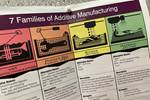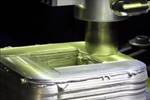Meld Manufacturing offers a solid-state metal additive manufacturing process: Metal parts are 3D printed in the open air, with no melting, using a process based on friction stir welding to apply the metal by deforming it. This video shows a Meld AM machine tool that 3D prints by rotating and compressing metal barstock.
Related resources:
- World’s Largest Metal 3D Printer Seen at Ingersoll Grand Opening Event
- How a Solid-State Process Stood Firm Until Additive’s Moment
Transcript
Peter Zelinski
I'm in Christiansburg, Virginia, Meld Manufacturing, seeing metal 3D printing without melting.
So Meld has a distinctive, unique approach to metal additive. The process uses friction stir welding to apply metal layer by layer. The metal is deformed, but it doesn't melt. The result is fully dense, solid metal parts properties approaching wrought material, and there are some advantages. Because there is no melting, because the material does not become liquid and solidify again, there aren't residual stresses. 3D printing can be applied to a thin substrate that will stay flat. This is a metal 3D printing process for materials that don't lend themselves to welding. This is 6061 aluminum. The process could be done with 7075 aluminum. Material handling is easy. The raw material is these square cross-section bars the process right now is using. It's running at the rate of about one 2-foot-long bar per minute. The bars are queued up in a magazine and load into the spindle that applies the pressure one by one by one.
Another advantage of the platform, this is a CNC machine tool. It is a machine that manufacturers recognize and know how to program using the same G code other machine tools do.
And because it's a machine tool, this process could be done for very big parts. Just need a very big machine tool to apply it. And because the process applies metal in an open environment, this is also a process for repair. Existing parts could be fixtured into the machine and Meld’s process could be used to 3D print just the feature that's needed for repair.
Related Content
-
BMW Group Vehicle to Adopt 3D Printed Center Console
A vehicle coming to market in 2027 will include a center console carrier manufactured through polymer robot-based large-format additive manufacturing (LFAM).
-
Evaluating the Printability and Mechanical Properties of LFAM Regrind
A study conducted by SABIC and Local Motors identified potential for the reuse of scrap reinforced polymer from large-format additive manufacturing. As this method increases in popularity, sustainable practices for recycling excess materials is a burgeoning concern.
-
8 Cool Parts From Formnext 2023: The Cool Parts Show #65
New additive manufacturing technologies on display at Formnext were in many cases producing notable end-use components. Here are some of the coolest parts we found at this year’s show.















